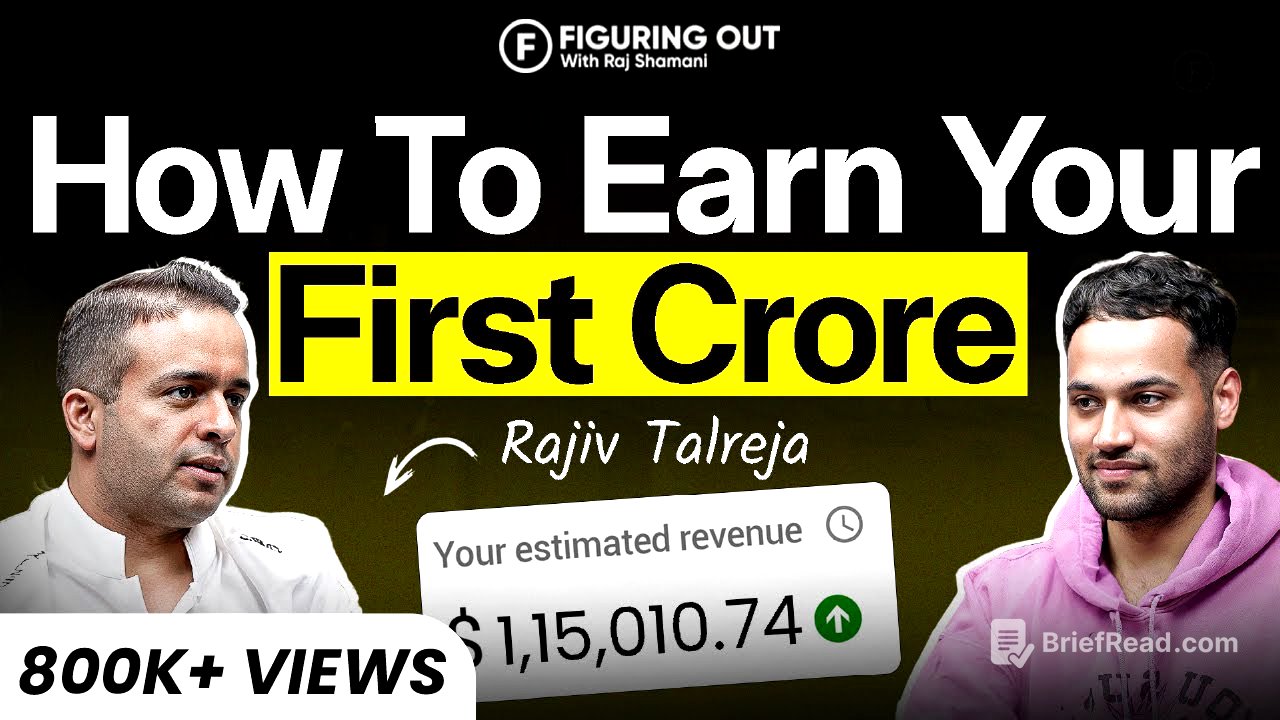TLDR;
This YouTube video by Raj Shamani explores the common misconceptions about building a business, particularly the idea that it's all about making money quickly. It discusses the different types of business owners, the importance of focusing on input rather than output, and the dangers of chasing fame over fundamentals. The video encourages self-reflection and clarity in defining personal goals and aspirations, rather than blindly following borrowed dreams or get-rich-quick schemes.
- Focus on building capabilities and providing value.
- Understand your motivations and avoid chasing external validation.
- Prepare for big dreams with realistic milestones and a strong foundation.
Introduction [0:00]
The video challenges the common misconception that building a business is solely about making money quickly. It highlights that efficiency, not just capital, is what drives success for business owners. The discussion also touches on how status and the desire for luxury can influence business decisions, often driven by marketing tactics that play on people's aspirations.
Business owners’ shortcomings [1:38]
The conversation addresses the shortcomings of business owners who rely on external factors like connections with influential people for growth. It stresses the importance of earned value exchange and building a business from scratch based on genuine capabilities. The discussion uses the example of a real estate client who initially empowered people from their personal network but faced challenges due to a lack of skills and experience within the team. This led to frustration among junior staff and a defensive attitude from senior management, hindering the company's overall progress.
4 types of business owners [7:22]
Raj Shamani identifies four types of business owners based on their primary goals: income-driven, identity-driven, financial freedom-driven, and legacy-driven. Income-driven owners focus on earning enough to meet their immediate needs, while identity-driven owners see having a business as an end goal in itself. Financial freedom-driven owners aim to build a business that generates enough income to invest in other assets and achieve financial independence. Legacy-driven owners prioritise building a lasting brand or institution that will outlive them. The discussion emphasises the importance of aligning business goals with personal values and avoiding the trap of comparing oneself to others.
Stop chasing money [15:30]
The video challenges the notion that everyone starts a business to become big, highlighting that many are content with a smaller, more manageable venture that aligns with their personal goals. It critiques the business media's tendency to celebrate only the top performers, which can create unrealistic benchmarks and a compulsion for external validation. The discussion stresses the importance of defining personal metrics for success and focusing on what truly matters to the individual, rather than chasing vanity metrics.
Big dreams, slow growth [19:31]
Raj shares a case study of a 21-year-old aspiring entrepreneur with an impressive business idea for sustainable mineral water packaging. Despite thorough research and a detailed presentation, the young man was waiting for a large investment rather than starting small and building incrementally. Raj emphasises the importance of preparing for big dreams by focusing on achievable milestones and building a solid foundation of skills, capital, and network. He contrasts this with the Zepto founders, who, despite having access to resources, started by building a proof of concept before seeking significant investment.
Raj case study [31:10]
Raj uses his own experiences as a case study, reflecting on how he initially chased wild dreams without a practical foundation. He acknowledges the importance of building capabilities and creating valuable content, which eventually led to angel investors from his podcast. This highlights the significance of earning the right to pursue larger ventures through preparation and genuine value creation, rather than solely focusing on pitch decks and accessible business media.
Ditch get-rich-quick schemes [34:13]
The discussion critiques the "get-rich-quick" mentality that pervades the business world, emphasising that true success comes from building a solid organisation and integrated systems. It highlights the importance of focusing on the inputs – skills, strategy, product, and reach – rather than solely chasing the output of money. The video uses the analogy of a shadow, explaining that the more you chase money, the more it eludes you; the key is to walk forward, focusing on value creation, and the money will follow.
Focus on input, not output [37:17]
The video stresses that business is a journey, not a "get rich quick" scheme. It uses the example of an employee frustrated with their stagnant salary, who mistakenly believes that starting a business will automatically lead to a better life. The discussion emphasises that money is an output, and success requires focusing on the inputs: product quality, skills, systems, and strategy. Investing in these capabilities is more crucial than simply throwing money at a flawed business model.
Fame vs. fundamentals [42:41]
The conversation explores the pitfalls of chasing fame over fundamentals, using the example of a B2B business owner who shifted to D2C in pursuit of recognition, only to find their quality of life deteriorating. It highlights that true fulfilment comes from creating value and impact, rather than seeking external validation. The discussion encourages listeners to focus on building a strong foundation and pursuing their purpose, rather than getting caught up in the swamp of limelight and attention.
Trapped in consumerism [53:06]
The video examines how consumerism and the desire for status can lead people to make irrational choices, such as buying luxury cars for social media posts rather than for the driving experience. It highlights the importance of self-awareness and clarity in defining personal values, rather than comparing oneself to others and falling victim to external validation. The discussion suggests that true freedom comes from making conscious choices based on internal desires, rather than seeking approval from others.
Breaking free from validation [1:01:30]
The discussion explores how to break free from the need for external validation and make conscious choices based on personal values. It acknowledges that while many people are driven by the desire to impress others, true fulfilment comes from a sense of wholeness and self-acceptance. The video encourages listeners to ask themselves who they want to be and what they truly need, rather than blindly following societal expectations or borrowed aspirations.
Self-reflection questions [1:03:57]
Raj provides a set of self-reflection questions to help listeners identify their true motivations and avoid the trap of external validation. These include asking oneself whether their actions are driven by a desire to prove something to others, and whether their intentions are pure and driven by love and connection. The discussion emphasises the importance of aligning one's choices with their deeper values and avoiding the bitterness that can result from chasing impure goals.
Borrowed aspirations [1:12:35]
The video stresses the importance of building real-world metrics for success and avoiding the trap of borrowed aspirations. It uses the example of a 21-year-old who was fixated on building a big brand without considering his personal resources and capabilities. The discussion emphasises the need to connect with one's true self and define goals that are relevant and achievable, rather than blindly following societal expectations.
Advice for Raj & young entrepreneurs [1:14:35]
Raj asks for advice on his strengths and weaknesses as a coach and entrepreneur. He is told that his strength lies in his genuine curiosity and his ability to stay true to his essence, even when tempted by fame and sensationalism. The advice suggests that his next level of growth involves transitioning to a mindset where he doesn't have to put himself on the line to achieve success, and instead, can trust in the power of compounding and the capabilities he has already developed.
BTS [1:25:45]
This section is just a short behind the scenes clip.
Outro [1:26:10]
The video concludes with a call to action, encouraging viewers to subscribe to the channel, share their thoughts in the comments, and share the episode with someone who might benefit from the conversation. It reinforces the idea that one conversation is enough to change someone's life.









